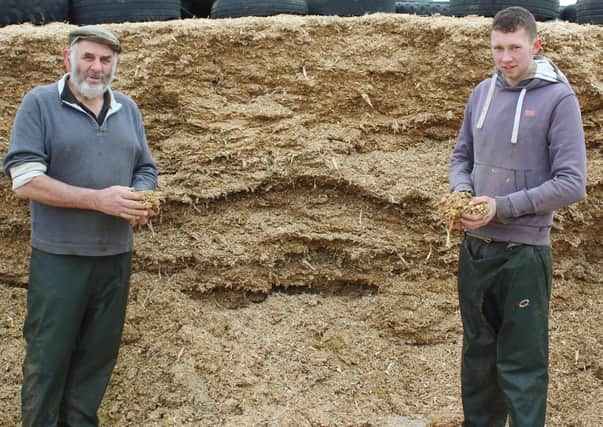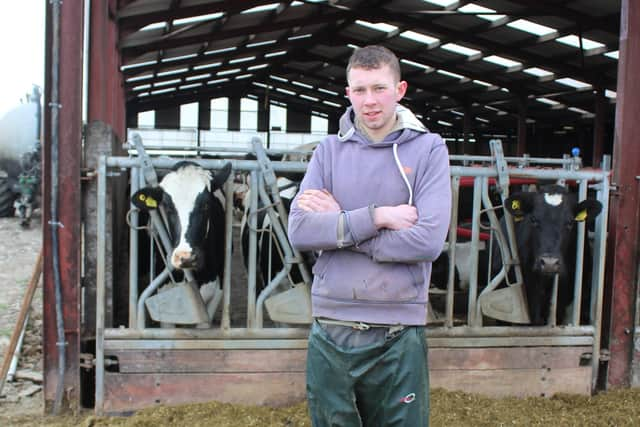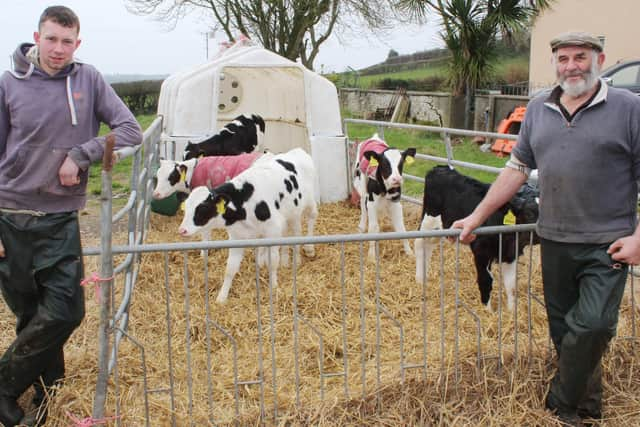Farming should be a young person’s game - but it’s not!


But not so, where farmers are concerned.
If one takes 58 as the average age of people ‘working the land’ right now, this means that there are significant numbers of people working on through to their late 70s and, possibly beyond. It also means there is a significant dearth of young people coming into the industry. But more of that anon.
I know that many older people continue working their farms because they view it as a way of life, which they enjoy immensely. For others, however, it is more a case of perceived necessity being the real driver. There is no next generation coming through to take over the business and they fear that if they don’t keep on working, they will be giving up an enterprise that they have spent their lives creating.


Advertisement
Advertisement
Any industry that is deprived of sufficient young blood coming through is in danger of becoming obsolete. Young people bring energy, vitality, new ideas and a never-say-die attitude.
So why is farming not attracting the numbers of young people it needs to generate a truly sustainable future for itself? To be honest, books have been written on the subject. But let’s stick to the most obvious reasons that come to the fore in this regard.
These include the demanding lifestyle associated with every farming sector and the almost never ending challenge of eking out a living, given the continuing downward pressure on farmgate returns, in tandem with the corresponding upward pressure on input costs.
Take milk production as a case in point. Dairy farming is a 365 day per year commitment on the part of those involved. Cows have to be milked twice daily, fed regularly and the sheds that the animals are kept in kept meticulously clean.


Advertisement
Advertisement
Add in the feeding of calves and young stock, not to mention the time taken to undertake the other regular jobs that must be completed on every dairy farm, and it’s not hard to compute a daily work load of at least 10 hours on the part of those involved in the business. So at a very fundamental level, this works out a commitment of 70 hours per week.
During the spring and summer months, the additional necessity of making silage and ensuring the grazing paddocks are managed correctly must also be factored-in. It all adds up to a total dedication to the job in hand, which doesn’t get any easier as the years tick by.
The good news is that lots of young people are brought up on farms across Northern Ireland many of whom attend agricultural college. But the problem is that so few of these high qualified and motivated young people want to come home to farm. Rather they see their futures more closely aligned to the agri business sector, both here and abroad.
Trying to get these people to look at a career in production agriculture is akin to shutting the stable door after the horse has bolted.
Advertisement
Advertisement
Another problem is that many of those people who do want to follow a career in farming view the inability to access the land they need as an insurmountable obstacle. For one thing, they don’t have the financial wherewithal to buy land while Northern Ireland’s continuing obsession with ‘conacre’ prevents them from accessing realistic acreages on a long-term, leased basis.
But it’s not all bad news. The signs are now apparent that agriculture in Northern Ireland is now starting to wake up and respond to the challenge of succession and the need to put young people front and centre as it looks to the future.
The first signs of this can be traced back to the young farmer support payments that were introduced courtesy of the reforms made to the Common Agricultural Policy a decade ago. And let’s hope this focus on young farmers support measures will be retained as agriculture in Northern Ireland looks forward to a future beyond Brexit.
But a development of even more significance, in terms of the recognition given to young farmers within agriculture, was the launch of the Land Mobility programme back in 2017. Funded initially by the Department of Agriculture, Environment and Rural Affairs (DAERA) and supported by the Ulster Farmers’ Union (UFU) and the Young Farmers’ Clubs of Ulster (YFCU), this ground breaking initiative has really succeeded in putting the issue of young people in farming and the need to deliver on the challenge of succession centre stage within the world of agriculture.
Advertisement
Advertisement
Driving the programme from the get-go has been former YFCU president and Rathfriland farmer John McCallister. He is quick to point to the relevance of the Young Farmers’ Clubs being selected as the organisation charged with the responsibility of converting the principles that are at the very heart of the land mobility into real progress on the ground.
John added: “At a very fundamental level, land mobility is all about matching older landowners, coming to the end of their careers in farming with younger people wishing to get a start within the industry.
“My job is to bring the various parties together and suggest business options that best meet the needs of everyone involved. These could include long term leasing, the development of share farming opportunities and even the setting up of new farm partnerships.
“By taking this approach, it ensures that land is kept in good heart and that all the parties involved have a role to play in making this happen.
Advertisement
Advertisement
“It really is a win:win scenario. The farming industry benefits from the fact that a new and valuable farm business opportunity is created; the land owner has the security of knowing that his/her much cherished asset will be kept in good heart and, of course, the young farmer can look forward to the future with a degree of confidence.”
But as John is also keen to confirm, land mobility is about much more than this. He commented: “The programme was established to encourage existing farm business to address the challenge of succession in a proactive and timely manner. “Northern Ireland agriculture is so fortunate in having a business structure based on a family farm model. But what happens in those cases when young people want to look at career opportunities other than farming.
“Land mobility provides an opportunity for families to follow a path that ensures their land is maintained in good heart while giving others a viable and much needed career development opportunity.”
So much for the theory! The real question is: how is all of this working out on the ground?
Advertisement
Advertisement
One of the most enlightened examples of the land mobility programme in action centres on the relationship that has developed over the past two years between former College of Agriculture, Food and Rural Enterprise (CAFRE) student Matthew Adams, who hails from Glarryford in Co Antrim, and Strangford dairy farmer Cavan Johnston.
They are currently involved in the development of a profit sharing arrangement, which looks set to evolve further over the next number of years. The Johnston farm, which extends to 440 acres, is home to 220 dairy cows and 130 followers.
Matthew takes up the story: “I have always wanted to farm and the opportunity to work with Cavan has made this a reality for me. The relationship was brought about by John McCallister. Cavan had previously indicated that he wanted to step back a bit from the day-to-day running of the business. But, at the same time, he also wanted to work with a young person who would have the enthusiasm to drive the business forward.
“John suggested me as the person who might fit the requirement. And that was the beginning of it. Two years later, the relationship is going from strength to strength.”
Advertisement
Advertisement
The profit sharing arrangement entered into by Matthew and Cavan sees the Glarryford man taking a monthly salary from the business. Cavan takes a monthly land rental fee from the farm and all profits are shared on an agreed basis at the end of the year.
Matthew continued: “The arrangement has been agreed on an informal basis up to this point. I am involved in all the day to day management decisions with regard to the running of the farm.”
The Glarryford man went on to confirm that a 10-year development for the business has been agreed.
He said: “It should be possible to push cow numbers up to 300. My preference is for a Holstein-type cow that will produce up to 10,000 litres of milk. It should also be possible to get 4,000 litres of milk from forage.”
Advertisement
Advertisement
The focus on milk from forage is already evident on the farm. Last year, six cuts of silage were taken with the first in the pit by the middle of April. Home grown maize is also helping to boost milk output from forage at the present time.
Cavan confirmed that the success of the venture to date is based totally on the strength of the relationship that has been built up between the two men. He said: “I am 72 years of age. My wife and I have worked hard to develop the farm business over many years.
“We have three children: one boy and two girls. My son is a vet while my daughters followed career opportunities that have taken them off the farm. However, we all want to see the farm developed and maintained as a sustainable business for the future.
“On that basis, simply renting the land out was never going to be an option. As soon as I heard about the land mobility programme, I contacted John and made him aware of my thoughts.
Advertisement
Advertisement
“It didn’t take me long to work out that Matthew and I could work well together. Our relationship is still evolving. Over the next few years, I see no reason why we cannot move to the stage of agreeing a formal partnership between us.”
Such an approach would give Matthew a real opportunity to build equity in the business.
“Everyone within the family is delighted that Matthew is on board. And it really is a case of building for the future.”
Truth be told, the building work referred to by Cavan has already started. The past 18 months have seen cow numbers increased by 70 head.
Advertisement
Advertisement
“We have also put in place a new dry cow house and calving area,” said Matthew. “The total investment required to make this happen was in the region of £200,000.”
Cavan is very conscious of the fact that young people like Matthew find it very difficult working with the likes of the banks when it comes to getting the finance they need to invest in new businesses.
He said: “The banks have to change their attitude in this regard. But there is also a need for government to step in and provide young people like Matthew with the support they need to develop sustainable careers for themselves.
“If the business plan is good enough and the people involved have the ability and commitment to make it work, then government should also play its part supporting these farm development opportunities.”
Advertisement
Advertisement
In addition to tailored capital grant schemes, John McCallister believes that the Inland Revenue (HMRC) should look at tax changes that can further boost the creation of share farming and farm business partnerships here in Northern Ireland and, indeed, further afield throughout the UK.
He said: “Such an approach has already been taken by the Revenue Commissioners in the Republic of Ireland to the extent that it has significantly pump primed the impact made by the land mobility programme in that part of the world.
“Taxation is not a devolved matter, so it will require decisions being taken by the Inland Revenue in London to give the land mobility programme the boost it needs.
“If we had a scenario within which land rental incomes could be availed of on a tax-free basis by older landowners, who have entered into long term leasing arrangement with a younger farmer, this could transform the means through which large areas of land can be kept in productive use.
Advertisement
Advertisement
“Such an arrangement could provide the older person with a very valuable pension pot, while allowing the younger person to develop a sustainable, long term business venture.”
Meanwhile, spring has sprung in South Co Down. Matthew and Cavan hope to have a batch of autumn calvers, that are already back in calf, out in the paddocks over the coming days.
The good news is that they have their plan in place and are totally committed to developing a future for the business that will evolve on an agreed basis.
But the question remains: why aren’t lots more people following in their footsteps?